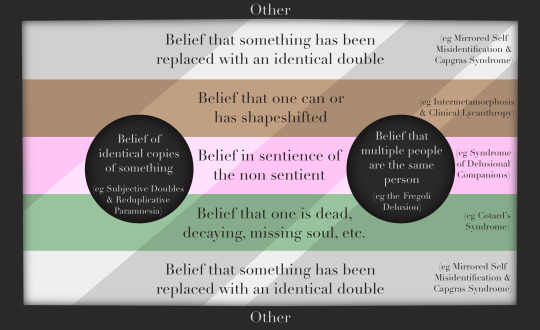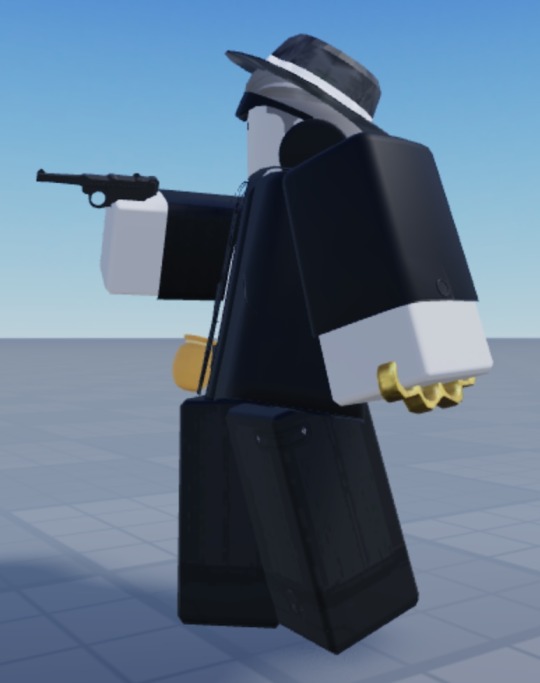#delusional misidentification
Explore tagged Tumblr posts
Text
man people HAAATE self aware psychotic people don’t they
#‘if you’re aware of a delusion it’s not a delusion’#uh sorry but have you ever heard of cognitive dissonance#i know i’m delusional i also know i’m a civet#you just want me to be unable to self advocate to use me like a lab rat fuck you#clinical zoanthropy#clinical lycanthropy#actually psychotic#delusional misidentification
21 notes
·
View notes
Text
Does anyone else get this thing with their delusions where, even if they didn’t necessarily wholeheartedly hold the delusion at the time in the past - you (present-state) will look back at your past and skew it as if you did?
I remember I used to acknowledge my ability to transform into a dog when I was very young, where it was therefore typical for kids to have “mythical thinking” if you will. But when I hit like.. 10-12/13 I stopped having said acknowledgment. I didn’t think I could transform iirc (psychosis makes memories fucking BLURRED), but then after - I’d say 13 - I wholeheartedly started having that acknowledgment again, ie: “I started believing the ‘false reality’ again”. (Gah, I hate even typing that but that’s the only way to make it make sense to others).
But my point here is that I will frequently look back at myself when I was in that time-period where the delusion was dormant, and I’ll still somehow remember transforming and being a dog at the time. I just didn’t believe it at the time I suppose? It’s all so confusing but this is just what I literally know, agh…
#dog talk#clinical cynanthropy#delusional misidentification#actually delusional#actually psychotic#actually schizophrenic
2 notes
·
View notes
Note
I have a question if you don't mind me asking.
Can someone's parts in a DID system have different types of delusional misidentification syndrome?
For example, say one part has mirror self misidentification whilst another has delusional companion syndrome?
answering this ask here too:
hiya , i have a question if ya dont mind answering . in OSDDID systems can only a few parts have clinical lycanthropy ? or is it a all or nothing thing ?
it depends what's causing the DMS. DMSs are different from other psychotic disorders / syndromes since they're very often caused by a physical factor, like a brain tumor or a TBI. so if the DMS is caused by a neurological disorder like dementia, or a psychological disorder with a biological component like schizophrenia, it'd be more likely that all alters would have it, as the biological aspects of those disorders affects the entire body.
if there's no biological basis for the DMS, then i think it would be possible for one part to have a DMS while others don't / have a different one.
with clinical zoanthropy specifically, you need to be careful that you're not confusing alters that are animals (as is common in DID), or alters that are therianthropes with CZ. it gets pretty confusing - some nonhuman alters are so disconnected from their shared body that they believe their shared body is also nonhuman. working on lessening dissociative barriers will help with this, though if they actually do have CZ it won't (because it's delusional, not dissociative). therianthropes, on the other hand, recognise their body as human and know their animal identity is only internal.
#dogasks#dissociative identity disorder#delusional misidentification syndrome#delusional misidentification of the self#delusional misidentification#clinical lycanthropy#clinical zoanthropy
11 notes
·
View notes
Text
Delusional Misidentification Syndrome


[ID: a 5 striped flag with a black border and shine effect on it. The stripes from top to bottom are silver, brown, pink, green, and silver. The second image portrays the same flag, but with labeling for each color’s meaning, which will be listed again under the cut.]
Delusional Misidentification Syndrome flag!! Can be used as an awareness flag or a pride flag, and is free for anyone to use ^v^
Black Border: general DMS delusions
Black Dots: Delusional belief of identical copies of something (such as in Subjective Doubles and Reduplicative Paramnesia) and delusional belief that multiple people are the same person (eg Fregoli Delusion)
Silver inner and outer stripe: Delusional belief that something has been replaced with an identical copy (eg Mirrored Self Misidentification and Capgras Syndrome)
Brown stripe: Delusional belief that one can or has shapeshifted (eg Intermetamorphosis and Clinical Lycanthropy)
Pink stripe: Delusional belief in sentience of the non sentient (eg Syndrome of Delusional Companions)
Green stripe: Delusional belief that one is dead, decaying, missing their soul, etc. (eg Cotard’s Syndrome)
#mad pride#dms#delusional misidentification syndrome#fregoli delusion#the fregoli delusion#mirrored self misidentification#capgras syndrome#intermetamorphosis#clinical lycanthropy#sdc#syndrome of delusional companions#cotards syndrome#cotards delusion#Tispy’s term hoard#dcs#delusional companion syndrome
24 notes
·
View notes
Text

PSINKTOBER: DAY 25: SCARECROW
#inktober#inktober 2024#psychiatry#psinktober#neuroscience#delusional misidentification syndrome#cotards delusion#mr. fregoli#scarecrow#prosopagnosia
13 notes
·
View notes
Text
we need to learn to breathe and relax and slow down. we're managing to do it now after reminding ourselves (and deleting multiple posts we were going to make originally). emotions get so intense, especially when they're bolstered by anger. we need to learn how to remind ourselves that no matter what others think, their thoughts are nothing to our self-perception, because they are not us.
(kind of hard to keep track of that last bit when we struggle to define "us" vs "other", but trying is better than nothing even when it's hard?)
#it's me#tw vent#we get so deeply fucking pissed off when people say things that imply they think we're delusional#or when we see them say things that lets us know they would think we're delusional if they knew us#we're *this* close to dropping CL/CZ as a term right now but we know we're probably overreacting because night time and anger#it feels like our skin is eating itself from the sheer hunger and wrath#we're a werecanid. a werebeast. right now we're a werewolf. what other people think won't change that.#and if they piss us off bad enough we can block them and never have to think about it again.#almost miss the days of calling ourselves a p-shifter because at least back then we didn't have to deal with people treating us as though--#--we were delusional AND belittling us at the same time.#they'd just treat us like we were delusional and evil instead lol#and one of those is way easier for the npd to handle because one of those respects the autonomy and power we have#we can't STAND people treating us as though we're helpless. as though we can't decide what's good for ourselves because of our schizophreni#CL/CZ were coined as delusional misidentification syndromes yes. it's *also* a label that is forcefully applied to us by humans#and it is easier for us to use in that way specifically because it means we're not fighting as much#but fuck man. some day someone in the street is going to see us for what we are and will fear and will fear greatly after seeing their--#--first ever werewolf (or whatever we are in that moment. probably wolf or coywolf.)#we just have to hang onto knowing that day will come and we will be fucking vindicated
2 notes
·
View notes
Text
I really don't understand why DMSs need like... something physically going on with the brain in order to "count" or be diagnosed. They're just a type of delusion yeah? So anyone with any capability of experiencing delusion should be able to have them. That makes more sense to me than saying that you need a traumatic brain injury or a brain tumor in order to experience them, or for your experience to count as DMS. If I didn't see mention that schizophrenia counted as a physical brain difference for DMS then I could've entirely written off my experiences with it as something else. Plus, how often do you think TBIs and schizophrenia and such go uncaught? Any sort of physical brain difference at all that goes unchecked, someone doesn't know they have it, and they see that DMS needs that physicality in order to count so they glance over it since as far as they're aware they lack that physical aspect? It's just duuuumb it's duuumb and stupiiiiid. If I'm completely missing something crucial here let me know but it just seems so... needless, when it's just another category of delusion. It's the only kind I've heard that needs that physical part to it or is attributed more to a physical brain cause like a TBI or dementia than to actual psychotic experience
I have beef with the removal of "simple schizophrenia" (schizophrenia with no positive symptoms) from the DSM as well since it wasn't replaced by anything. So imagine how many people have the cognitive and negative aspects of schizophrenia, don't fit criteria for other disorders with similar symptoms, but because they don't have psychosis they can't be diagnosed. It's ridiculous. All my homies hate the DSM
EDIT: I should say, all that stuff about DMSs is stuff I've seen specifically about delusional companion syndrome, but I've seen it for others in the category as well. DCS is so hard to research I'm unsure if it's diagnosable or not without evidence of physical brain stuff going on. So take it all with a grain of salt. Either way it's way WAAAAY underdiagnosed
#change the criterion for dms#delusional misidentification syndrome#and bring back simple schizophrenia. my best friend simple schizophrenia#schizophrenia#dcs#delusional companion syndrome#post#sorry for this Hot Discourse i had a thought and needed to run with it#Anyway if your experience with posic stuff is delusional and/or disordered#look into dcs. not that you really can its hardly recognized
3 notes
·
View notes
Text
is there a term for a delusion that you are literally a fictional character that ISNT "delusional attatchment"? im so sick of this subject falling in the hands of bad people
#i am also really sick of sanists pretending this kind of thing doesnt exist#or that its kinnie stuff#this is a serious delusion i deal with it almost every other day/week#delusional misidentification syndrome#using that for reach but that isnt even the right term either#schizospec#actually psychotic#actually schizospec
14 notes
·
View notes
Text





IaMD!Chance
They/them
Sentinel
Gambler
Gun no longer blows up, but it still has a 5% chance to not fire.
He also has a block just like Elliot's
(HE FUCKING FIXED IT FINALLY)
He now suffers from Capgras Syndrome ever since Mafi used his appearance to attack the team one round. He has friendly fire active because of this, just like Guest 1337.
Capgras Syndrome:
The syndrome associated with the belief that someone familiar has been replaced by an identical double is called Capgras Syndrome. It's a delusional misidentification syndrome where the individual believes a loved one, or even an inanimate object, has been replaced by an imposter. (This also includes Chance's reflection or even alternate versions of himself)
#its a mad dash!#au#roblox#homicidalporkchops#roblox forsaken#forsaken roblox#roblox dream game#dream game roblox#chance forsaken
28 notes
·
View notes
Text

Source
GenderNH is an umbrella term for a gender which is impacted by being nonhuman in some way. This includes but is not limited to otherkin, copinglinkers, nonhumans in systems, delusional misidentification, vampires, and any alterhuman.
Being GenderNH is not inherently transgender or non-binary, though genderNH individuals may be. The term can include cis nonhumans who feel like their gender is still impacted by a nonhuman identity.
Not coind or made by me, just a repost
#therian#alterhuman#nonhuman#transspecies#therian coining#alterhuman coining#nonhuman coining#therian community#alterhuman community#nonhuman commuity#liom#liom coining
33 notes
·
View notes
Text
I have internal nonhuman identities, and external nonhuman identities.
Sometimes they overlap, sometimes they do not. My external clinical zoanthropy can inform my internal identity, and vice versa.
In saying that, my CZ and other non-CZ related identities are NOT the same experience.
#clinical zoanthropy#clinical lycanthropy#clinical dracothropy#delusional misidentification syndrome#alterhuman#nonhuman#alterbeing
2 notes
·
View notes
Text
no one wants to talk about this for obvious reasons, but there is a link between clinical zoanthropy and zoophilia (in some cases, acting on zoophilia seem to induce CZ, and in other cases its the other way round)... makes me wonder if there is also a link between Cotard's and necrophilia?
#i had a quick look into it but couldnt find anything relevant#dogpost#delusional misidentification syndrome#paraphilias#no bold
11 notes
·
View notes
Text
Fantasilis flag

Fantasilis is a term describing when an individual cannot separate or disconnect their identity from fantasy, fiction, or make-believe.
Said individual can separate reality from fantasy but cannot see their identity as anything other than fantasy due to comfortability. Fantasilis is can come from anything, but primarily shows up in younger individuals who still have a heavy exposure to fantasy without a developed personality.
Can appear in those with fantasy-prone disorder, autism, and/or neuronarration.
Not to be confused with psychosis or delusional misidentification.
Individuals with fantasilic identities may have:
out of body experiences
phantom senses from fantasies or daydreams
morphing/inconsistent or unstable identities
hallucinations
#fantasy#madd#disorder#maladaptive daydreaming#fantasilis#fantasilic#mogai coining#liom coining#flag#flag coining#vexillology#disability#disabled#disabilties#actually mentally ill#mental illness#mentally fucked
34 notes
·
View notes
Text
hey uhhhh im new to tumblr so. lemme introduce myself.
i’m damien / lucifer.
14.
i go by He/xe/they/it pronouns. He is preferred. capitalize the H. im your lord.
i mostly downloaded this app cuz i wanted to vent and have friends to support me.
facts about me.
- i have a god complex, i’m getting the help i need from my friend. (funding my therapy.)
- i also have delusions, delusional attachments/misidentifications, and parasocial delusions.
- i’m damien thorn and kokichi ouma irl.
- i kin light yagami, not irl.
- i’m a hyena therian.
- i am a black rat therian.
- i like dark humor.
- i like conspiracy theories.
- i’m a darkshipper/comshipper. NOT A PROSHIPPER, just a sucker for toxic yaoi.
- proship is fine tho, just not for me tbh.
dni list.
- anti south park.
- anti-shippers.
- homophobes/transphobes. pfft, i could make you gay if i really wanted to, don’t you understand IM GOD? *giggles.*
- preppy people. we just don’t get along.
- people that insult me. kneel before me, fool.
interests.
- south park
- hell park
- danganronpa
- death note
- boyfriends (webtoon.. it’s good i promise 😭)
- moral orel
- superjail
- smiling friends
- ICP
- slipknot
- falling in reverse
- korn
that’s all. enjoy my blog, fools.
#intro post#god complex#irl yandere#satanism#slipknot#falling in reverse#south park#hellpark#comshippers please interact#comship#darkship#dark aesthetic#comshipper safe#comshippers are valid#darkshippers please interact#darkshipper safe#2000s emo#emo scene#transgender#transmasc#lgbtq community#introduction#blog intro#pinned intro#introductory post#landmineblr#landmine type#landmineblogging#landmine boy#neetcore
10 notes
·
View notes
Text
alright here's round two
(sorry for the delay I was procrastinating :3)
Winner of round one :
Imposter Syndrome
Invasive Surgery
The Rhine
you know, the funny thing is that I dont even ship these two. talk about public service.
I swear to god if yall put any more names in the comments I will not hesitate to make a third round with considerable delay just like this one

okay yippee lets go remember to reblog !!
#tf2#196#rule#team fortress two#gentle surgery#tf2 medic#medic tf2#spy tf2#tf2 spy#tf2 gentle surgery#gentle surgery tf2#poll#tf2 poll#tf2 fandom#tf2 mercs#spy x medic#medic x spy#:3#tfc#team fortress classic#i summon you ALL#medic/spy#spy/medic#alr here goes
134 notes
·
View notes
Note
Delusional plural culture is literally never knowing if you're experiencing a Delusional attachment, a misidentification, or another persona/alter...
.
#endos dni#osdd#did#pdid#did system#pdid system#osddid#actually did#traumagenic#actually dissociative#plural culture is
29 notes
·
View notes